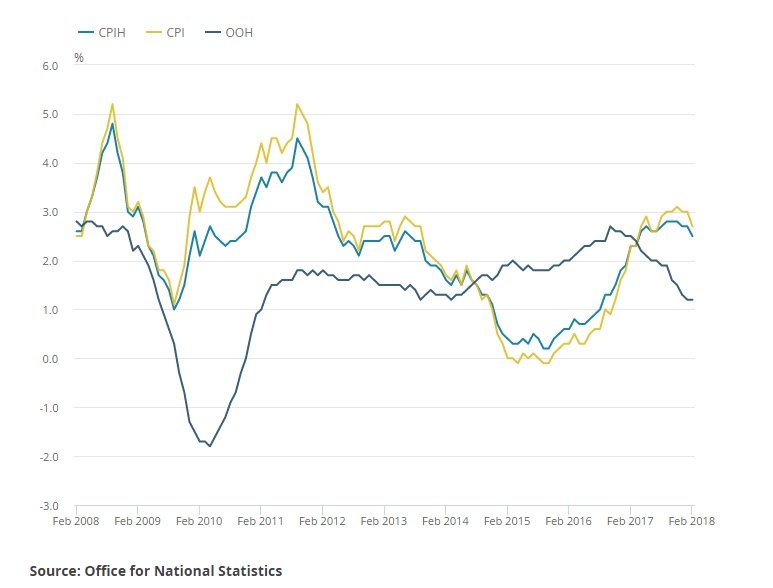- With post-Brexit Sterling depreciation effect on the UK inflation dissipating, the UK inflation is set to normalize at lower levels in 2018.
- The headline inflation in the UK is forecast to decelerate to 2.7% y/y in March.
- With inflation still way above the Bank of England target, the rate hike forecast becomes a sure shot on May 10, 2018.
The GBP/USD is trading near its 2018 high of 1.4377 that also represents the highest level of Sterling since post Brexit referendum slump and this is the reason why inflation in the UK is set to decelerate near-term.
The same rationale applies to the figures from the Office for National Statistics for consumer price index (CPI) in March. The headline CPI is expected to rise 0.3% over the month in March bringing the year-to-year comparison lower to 2.6%, down from 2.7% y/y in February and down from inflation’s cyclical peak of 3.1% y/y back in November last year. At the same time core inflation strip[ping the consumer basket of food and energy prices is expected to remain steady rising 2.4% over the year in March, just off the peak of 2.7% y/y rolling constantly since August to December of last year.
Of course, there is a number of other inflation indices in the ONS report including retail price index (RPI), producer price indices (PPI) on both input and output side as well as the house price index (HPI), but in terms of the monetary policy, they are irrelevant.
The Bank of England has tolerated higher inflation in the UK in the post-Brexit economic environment as sharp Sterling’s depreciation resulted in higher prices, especially for imported goods, but now it is ready to act on rates. The Bank of England lifted the Bank rate for the first time in last decade in November last year and it actually turned a bit more hawkish in February this year saying there might be more than just two Bank rate adjustments in next three years.
Related stories
The major source of uncertainty for the central bank remains post Brexit relationship of the UK with the European Union and with the trade deal extension to December 2020 fear of hard-landing threat eased so the Bank of England might be willing to accept the scenario of inflation gradually decelerating while tight labor market will result in solid wage increases generating more fundamentally justified reason for the monetary policy precautionary tightening.
So the nominal wage growth might temporarily disappoint the market expectations and result in Sterling being sold off against the US Dollar from its post Brexit high, but the long-term driver of inflation decelerating promoting the real, inflation-adjusted wages to rise and Sterling to appreciate as the scenario of 25 basis points Bank rate increase become the central expectation for the market almost a month before the May Inflation Report is due on May 10, 2018.
A decade of the UK inflation
Note: All information on this page is subject to change. The use of this website constitutes acceptance of our user agreement. Please read our privacy policy and legal disclaimer. Opinions expressed at FXstreet.com are those of the individual authors and do not necessarily represent the opinion of FXstreet.com or its management. Risk Disclosure: Trading foreign exchange on margin carries a high level of risk, and may not be suitable for all investors. The high degree of leverage can work against you as well as for you. Before deciding to invest in foreign exchange you should carefully consider your investment objectives, level of experience, and risk appetite. The possibility exists that you could sustain a loss of some or all of your initial investment and therefore you should not invest money that you cannot afford to lose. You should be aware of all the risks associated with foreign exchange trading, and seek advice from an independent financial advisor if you have any doubts.
Recommended Content
Editors’ Picks

EUR/USD treads water just above 1.0400 post-US data
Another sign of the good health of the US economy came in response to firm flash US Manufacturing and Services PMIs, which in turn reinforced further the already strong performance of the US Dollar, relegating EUR/USD to the 1.0400 neighbourhood on Friday.

GBP/USD remains depressed near 1.2520 on stronger Dollar
Poor results from the UK docket kept the British pound on the back foot on Thursday, hovering around the low-1.2500s in a context of generalized weakness in the risk-linked galaxy vs. another outstanding day in the Greenback.

Gold keeps the bid bias unchanged near $2,700
Persistent safe haven demand continues to prop up the march north in Gold prices so far on Friday, hitting new two-week tops past the key $2,700 mark per troy ounce despite extra strength in the Greenback and mixed US yields.

Geopolitics back on the radar
Rising tensions between Russia and Ukraine caused renewed unease in the markets this week. Putin signed an amendment to Russian nuclear doctrine, which allows Russia to use nuclear weapons for retaliating against strikes carried out with conventional weapons.

Eurozone PMI sounds the alarm about growth once more
The composite PMI dropped from 50 to 48.1, once more stressing growth concerns for the eurozone. Hard data has actually come in better than expected recently – so ahead of the December meeting, the ECB has to figure out whether this is the PMI crying wolf or whether it should take this signal seriously. We think it’s the latter.

Best Forex Brokers with Low Spreads
VERIFIED Low spreads are crucial for reducing trading costs. Explore top Forex brokers offering competitive spreads and high leverage. Compare options for EUR/USD, GBP/USD, USD/JPY, and Gold.
